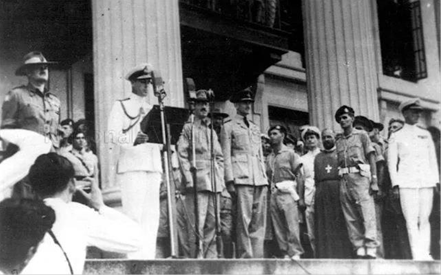Sport in Syonan: Triumph Over Despair - Chapter 12 | Conclusion

▶ Download: Sport in Syonan: Triumph Over Despair - Chapter 12 | Conclusion
%20Conclusion%20(2022).jpg?width=500&height=312&name=Sport%20in%20Syonan%20(12)%20Conclusion%20(2022).jpg) Admiral Lord Louis Mountbatten, British Supreme Allied Commander, Southeast Asia, delivering a speech at the steps of Municipal Building (City Hall) after the Japanese surrender on 12 September 1945, marking the official end of the Japanese Occupation. 1945. Source: RAFSA Collection, courtesy of National Archives of Singapore (Media - Image No: 20170000053 – 1727)
Admiral Lord Louis Mountbatten, British Supreme Allied Commander, Southeast Asia, delivering a speech at the steps of Municipal Building (City Hall) after the Japanese surrender on 12 September 1945, marking the official end of the Japanese Occupation. 1945. Source: RAFSA Collection, courtesy of National Archives of Singapore (Media - Image No: 20170000053 – 1727)
%20Conclusion%20(2022)%202.webp?width=500&height=365&name=Sport%20in%20Syonan%20(12)%20Conclusion%20(2022)%202.webp)
%20Conclusion%20(2022)%203.jpg?width=500&height=384&name=Sport%20in%20Syonan%20(12)%20Conclusion%20(2022)%203.jpg) Spectators at Victory Rally at the Padang after the Japanese Surrender and end of over 3 years of occupation in Singapore. 10/10/1945. Source: David Ng Collection, courtesy of National Archives of Singapore (Media - Image No: 19980005701 - 0008 and No:19980005701 – 0005)
Spectators at Victory Rally at the Padang after the Japanese Surrender and end of over 3 years of occupation in Singapore. 10/10/1945. Source: David Ng Collection, courtesy of National Archives of Singapore (Media - Image No: 19980005701 - 0008 and No:19980005701 – 0005)
Impact of War on Sporting Culture
Singapore’s current sport culture emerged battered but not disabled from the ruins of war. As a remnant of happier times, it was able to rejuvenate spirits and provide an optimistic view of the future.
Sport uplifted spirits in a time of despair and helped build resilience amid adversity.
Sport was also a distraction from austerity.
Over time, the colonial rulers of old were stung by the shame of defeat, and lost influence over clubs. Post-war, sport became part of national identity in the fledgling nation.
Humanising Force of Sports
In war and sport, there are always winning and losing sides. It is how we respond to defeat and adversity that defines us.
For sportsmen during the occupation, such as pioneer Olympians Chia Boon Leong, Chua Boon Lay, Chu Chee Seng, Lloyd Valberg (b.1922-d.1984), and many others, survival meant not be consumed by defeat, but to find the will to bounce back.
The sporting community of Syonan contributed to critical functions by clearing streets, helping to restore the city’s basic amenities and building public air raid shelters.
Despite hardships, survivors of WWII adapted and persevered. The individual and community fighting spirit shone through in the worst of times, and the positive and humanising force of sport was none so evident as during depraved conditions of war.
Dark Side and Brighter Side
Paradoxically, during this period of oppression the Japanese embraced the affective quality of sport in nationalising disparate social groups in Singapore. It was a way of maintaining control. There was a dark side and a brighter side. Being good at sport paved the way for opportunities.
Meanwhile, Mamoru Shinozaki (1908 – 1991), who clearly related well with members of the Syonan Sport Association, remains a controversial figure till today. Detractors accuse him of distorting history to portray himself in a positive light, whilst others have lauded him for his humanity and genuine welfare, labelling him the “Schindler of Singapore”.
Fraternising with the Enemy
While competing together – and sometimes, with our foes – our shared humanity became self-evident. During the occupation, locals and POWs played games with or against the Japanese, for the love of sport transcends nationalities and gender. In the final analysis, all men and women are equals regardless of race or creed.
%20Conclusion%20(2022)%204.jpg?width=500&height=380&name=Sport%20in%20Syonan%20(12)%20Conclusion%20(2022)%204.jpg)
Victory Parade at the Padang in front of the Municipal Building (City Hall). 1945. Source: Tham Sien Yen Collection, courtesy of National Archives of Singapore (Media - Image No: 20080000015 – 0087)
%20Conclusion%20(2022)%205.jpg?width=500&height=317&name=Sport%20in%20Syonan%20(12)%20Conclusion%20(2022)%205.jpg)
Victory Parade by the British and Australian Navy at the Padang. 07/01/1946. Source: David Ng Collection, courtesy of National Archives of Singapore (Media - Image No: 19980005785 – 0037)
Shifting the Game
The competition for opportunities increased the seriousness of sport and physical education, while at the same time the seriousness of war also had the unintended consequence of shifting the game.
The function of sport shifted from play and socialisation, to one of personal fitness with an emphasis on the disciplining of the body into the production of a combat-ready citizenry.
%20Conclusion%20(2022)%206.jpg?width=500&height=368&name=Sport%20in%20Syonan%20(12)%20Conclusion%20(2022)%206.jpg)
Post-war: Olympian Lloyd Valberg (1948 London Olympics) in an exhibition leap in Sydney. c.1947-1950. Source: Singapore Sports Council (Media - image no: 19980005603 – 0032)





![ActiveSG Academies and Clubs Logo (Solid Colour)[8647]](https://www.activesgcircle.gov.sg/hs-fs/hubfs/ActiveSG%20Circle%202023Theme/images/ActiveSG%20Academies%20and%20Clubs%20Logo%20(Solid%20Colour)%5B8647%5D.png?width=150&height=65&name=ActiveSG%20Academies%20and%20Clubs%20Logo%20(Solid%20Colour)%5B8647%5D.png)




-01.png?width=200&height=141&name=Team%20Singapore%20Logo%20(Red)-01.png)







